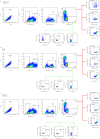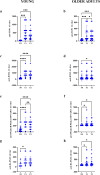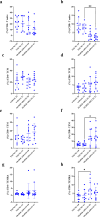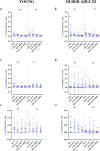Enhancing flu vaccine responses in older adults: preliminary insights from the ISOLDA study on immunosenescence and antioxidant and anti-inflammatory approaches
- PMID: 40140897
- PMCID: PMC11938677
- DOI: 10.1186/s12979-025-00506-y
Enhancing flu vaccine responses in older adults: preliminary insights from the ISOLDA study on immunosenescence and antioxidant and anti-inflammatory approaches
Abstract
Aging is frequently characterized by an inadequate primary vaccine response, likely due to immunosenescence and inflamm-aging, a low-level, chronic inflammatory state. Both aspects increase the susceptibility of older adults to viral and bacterial infections, resulting in a higher frequency and severity of infectious diseases. In this preliminary study, a cohort of 52 individuals was recruited and divided into two groups: young (age range 21-35) and older adults (> 60 years old). Peripheral blood mononuclear cells (PBMCs) were collected before (time 0, T0) and after (time 1, T1) the immunization with a tetravalent influenza vaccine. Then, T cell immunophenotyping analysis was conducted to investigate how aging and influenza vaccination influence T cell responses. Additionally, the anti-inflammatory and antioxidant effects of oleuropein (OLE), a secoiridoid extracted from extra virgin olive oil, alone or in combination with BIRB 796, a potent inhibitor of p38 MAPK, were explored to enhancing the impact of influenza virus on T cell activation, aiming to identify potential alternatives or complementary strategies to improve traditional flu-vaccine formulations. Statistically significant observations were noted for a decrement in CD8 + T naïve and an increase of effector memory between the young and older adults after flu-vaccination. Moreover, preliminary findings indicate anti-inflammatory and antioxidant properties of OLE and BIRB 796 on T cell responses, particularly regarding Reactive Oxygen Species/Reactive Nitrogen Species modulation, with a trend toward the decrease of pro-inflammatory cytokines (i.e., Interferon-γ (INF-γ), Tumor Necrosis Factor-α (TNF-α)), αalthough without statistical significance.
Keywords: Immunosenescence; Inflamm-aging; Influenza; Older adults; Oleuropein; Vaccine.
© 2025. The Author(s).
Conflict of interest statement
Declarations. Ethics approval and consent to participate: The protocol study was approved by The Ethics Committee of Palermo University Hospital (Improved vaccination strategies for older adults -ISOLDA- SEP-210574926, No. 01/2020). Consent for publication: Not applicable. Competing interests: The authors declare no competing interests.
Figures









Similar articles
-
Influenza vaccine-mediated protection in older adults: Impact of influenza infection, cytomegalovirus serostatus and vaccine dosage.Exp Gerontol. 2018 Jul 1;107:116-125. doi: 10.1016/j.exger.2017.09.015. Epub 2017 Sep 27. Exp Gerontol. 2018. PMID: 28958701 Free PMC article. Clinical Trial.
-
Signs of immunosenescence correlate with poor outcome of mRNA COVID-19 vaccination in older adults.Nat Aging. 2022 Oct;2(10):896-905. doi: 10.1038/s43587-022-00292-y. Epub 2022 Oct 14. Nat Aging. 2022. PMID: 37118289 Free PMC article.
-
Targeting Inflammation and Immunosenescence to Improve Vaccine Responses in the Elderly.Front Immunol. 2020 Oct 14;11:583019. doi: 10.3389/fimmu.2020.583019. eCollection 2020. Front Immunol. 2020. PMID: 33178213 Free PMC article. Review.
-
Better Response to Influenza Virus Vaccination in Physically Trained Older Adults Is Associated With Reductions of Cytomegalovirus-Specific Immunoglobulins as Well as Improvements in the Inflammatory and CD8+ T-Cell Profiles.Front Immunol. 2021 Oct 12;12:713763. doi: 10.3389/fimmu.2021.713763. eCollection 2021. Front Immunol. 2021. PMID: 34712226 Free PMC article.
-
Remodeling of the Immune Response With Aging: Immunosenescence and Its Potential Impact on COVID-19 Immune Response.Front Immunol. 2020 Aug 7;11:1748. doi: 10.3389/fimmu.2020.01748. eCollection 2020. Front Immunol. 2020. PMID: 32849623 Free PMC article. Review.
Cited by
-
Geroprotective applications of oleuropein and hydroxytyrosol through the hallmarks of ageing.Geroscience. 2025 May 27. doi: 10.1007/s11357-025-01697-4. Online ahead of print. Geroscience. 2025. PMID: 40425998 Review.
References
-
- Influenza vaccine viruses and reagents [Internet]. 2024. Available from: https://www.who.int/teams/global-influenza-programme/vaccines [Accessed June 5, 2023].
-
- European Centre for Disease Prevention and Control [Internet]. Available from: https://www.ecdc.europa.eu/ [Accessed November 8, 2023].
-
- Demicheli V, Jefferson T, Di Pietrantonj C, et al. Vaccines for preventing influenza in the elderly. Cochrane Database Syst Rev. 2018;2:CD004876. 10.1002/14651858. - PubMed
-
- Dean AS, Moffatt CRM, Rosewell A, et al. Incompletely matched influenza vaccine still provides protection in frail elderly. Vaccine. 2010;28:864–7. 10.1016/j.vaccine.2009.03.024. - PubMed
LinkOut - more resources
Full Text Sources
Research Materials

